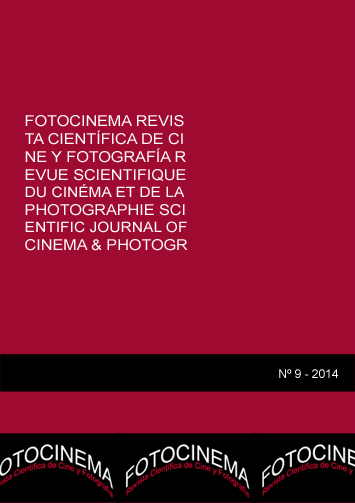Simbolismo de agua en el cine: entre el orientalismo poético ruso y el catastrofismo occidental
DOI:
https://doi.org/10.24310/Fotocinema.2014.v0i9.5970Abstract
La representación de agua en las artes visuales tuvo siempre una potente carga simbólica que se nutrió de las tradiciones religiosas y filosóficas de todo el mundo. En función del contexto cultural, este elemento puede hacer referencia a la idea del nacimiento, a la búsqueda espiritual, al subconsciente, a la vía que une el mundo de los vivos y los muertos, etc. La aparición del cine, como un género que da vida a una imagen fija, proporciona al artista la posibilidad de explorar la totalidad de las posibilidades expresivas de las “aguas que corren” convirtiéndolas en un recurso visual recurrente en las obras cinematográficas de todo el mundo. En este artículo ofrecemos un estudio de la presencia acuática como argumento plástico y simbólico en el cine, centrando nuestra atención sobre todo en el análisis comparativo de las producciones rusas y occidentales. En este sentido, las primeras ofrecen un simbolismo acuático afine a la tradición oriental y las segundas se decantan por la línea del catastrofismo.
Abstract:
The representation of water in the visual arts always had a powerful symbolism that was nurtured by religious and philosophical traditions all over the world. Depending on the cultural context, this element can refer to the idea of ??birth, to the spiritual quest, the subconscious, the road linking the world of the living and the dead, etc. The emergence of cinema as a genre that gives life to a still picture, gives the artist the opportunity to explore expressive possibilities of the "flowing waters" making a visual recurring resource in cinematographic works all over the world. In this article we provide a study of aquatic presence as symbolic and plastic argument in the film, focusing our attention mainly on the comparative analysis of Russian and Western productions. In this sense, the firsts offer aquatic symbolism tune to the Eastern tradition and the seconds opt for the line of catastrophism.
Palabras clave:
Agua; cine; búsqueda espiritual; oriental; occidental; modernidad líquida.
Keywords:
Water; Cinema; Spiritual Search; Eastern; Western; Liquid Modernity.Downloads
Metrics
Publication Facts
Reviewer profiles N/A
Author statements
Indexed in
-
—
- Academic society
- N/A
- Publisher
- Universidad de Málaga
Downloads
Published
How to Cite
Issue
Section
License
All contents published in Fotocinema Revista científica de cine y fotografía are protected under the Creative Commons Attribution-NonCommercial-ShareAlike 4.0 International (CC BY-NC-SA 4.0) license. All about this license is available in the following link: <http://creativecommons.org/licenses/by-nc-sa/4.0>
Users can copy, use, redistribute, share and exhibit publicly as long as:
- The original source and authorship of the material are cited (Journal, Publisher and URL of the work).
- It is not used for comercial purposes.
- The existence of the license and its especifications are mentioned.
There are two sets of authors’ rights: moral and property rights. Moral rights are perpetual prerogatives, unrenounceable, not-transferable, unalienable, imprescriptible and inembargable. According to authors’ rights legislation, Fotocinema. Revista científica de cine y fotografía recognizes and respects authors moral rights, as well as the ownership of property rights, which will be transferred to University of Malaga in open access. The property rights are referred to the benefits that are gained by the use or the dissemination of works. Fotocinema. Revista científica de cine y fotografía is published in an open access form and it is exclusively licenced by any means for doing or authorising distribution, dissemination, reproduction, , adaptation, translation or arrangement of works.
Authors are responsable for obtaining the necessary permission to use copyrighted images.














13.png)



